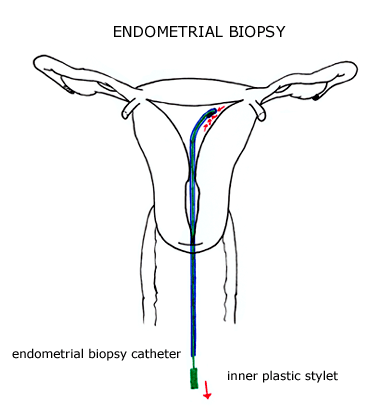|
Endometrial Biopsy

An endometrial biopsy may be performed for many different reasons. To evaluate the maturation of the uterine lining following ovulation, to assure (as best as is possible) that the progestagenic effect is adequate for embryo implantation and the development of a normal pregnancy, the endometrial biopsy is most often performed about 10 days after ovulation.
An attempt should be made to determine the exact day of ovulation during the cycle in which an endometrial biopsy is obtained. I prefer both basal body temperature charting and ovulation (LH) kit results if available. The biopsy is then performed about 10 days after presumed ovulation.
The need to contracept on an endometrial biopsy cycle, or the utility of a pregnancy test so soon after ovulation is controversial. I generally suggest a urine pregnancy test on the day of the procedure since occasionally a woman will have vaginal bleeding in early pregnancy (that is mistaken for a menstrual flow) and may therefore be pregnant at about 6-7 weeks gestation at the time of the endometrial biopsy.
A vaginal speculum is placed, the cervical canal centered between the blades of the speculum, the cervix is cleansed with betadine (or other appropriate agent), a sterile endometrial catheter is bent so that it is slightly curved at the tip (to help to negotiate the curved cervical canal), the catheter is passed through the cervix into the uterine cavity (which can generate a uterine crampy sensation), the inner plastic stylet is partially withdrawn from the other catheter sheath so as to produce a little bit of suction within the catheter and at the opening of the catheter (at its tip within the uterus), the catheter is slowly moved to and fro (while a sample of the endometrial tissue that would otherwise be shed as the menstrual flow is drawn into the catheter), the catheter is removed from the uterus, and the tissue within the catheter is placed in fixative (formalin) and sent to a pathology lab for histologic (microscopic) preparation and evaluation.
The endometrial biopsy does not usually cause much discomfort, but there is often a sharp discomfort for the few seconds that the catheter is actually within the uterine cavity. This discomfort generally subsides very quickly once the test is finished. There can also be a small amount of bleeding after the endometrial biopsy. A fever should not develop after the biopsy and if it does then you should immediately contact your physician.
|

|